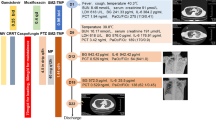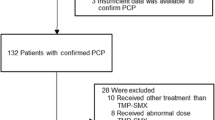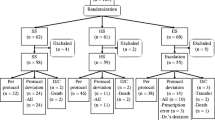Abstract
To evaluate the efficacy of primary prophylaxis for Pneumocystis jiroveci pneumonia (PCP) in patients with connective tissue disease (CTD) and immunosuppression, we compared trimethoprim–sulfamethoxazole (TMP-SMZ) with aerosolized pentamidine. Forty-eight CTD patients of Kitasato University Hospital whose CD4+ lymphocyte count in the peripheral blood was less than 300 μl−1 were reviewed from 2002 to 2004. Twenty-seven patients received TMP–SMZ and none of them developed PCP. Among 18 patients receiving aerosolized pentamidine, three patients developed PCP. These data indicate that TMP–SMZ is better for prophylaxis than aerosolized pentamidine.
Similar content being viewed by others
Avoid common mistakes on your manuscript.
Introduction
Pneumocystis jiroveci pneumonia (PCP) occurs in patients with impaired cellular immunity, especially debilitated premature infants, patients with primary immunodeficiency, patients on immunosuppressive therapy, and most commonly patients with human immunodeficiency virus (HIV) infection [1, 2]. Considerable progress has been made in the treatment of connective tissue disease (CTD) through the use of potent immunosuppressive agents. However, we encounter PCP quite often in this field because of the marked immunosuppression caused by corticosteroids and other immunosuppressants [3]. In patients with CTD, PCP may have a higher mortality rate than it does in patients with HIV [4].
For primary prevention of PCP in HIV patients, oral trimethoprim–sulfamethoxazole (TMP–SMZ) and aerosolized pentamidine are commonly used [1]. In patients with AIDS, TMP–SMZ has been shown to be more effective than aerosolized pentamidine at conventional doses for the prevention of primary and recurrent PCP. Recent studies have also shown that TMP–SMZ the first choice for prophylaxis in HIV patients [1, 2]. In CTD patients, we also choose TMP–SMZ for primary prophylaxis when they develop immunodeficiency. However, especially in patients with systemic lupus erythematosus (SLE) adverse effects of TMP–SMZ such as allergic reactions and renal dysfunction are not uncommon [5, 6]. In such cases, we use aerosolized pentamidine as the first-line drug.
Although several studies have examined the efficacy of these two drugs, there have been no reports of a comparison between their prophylactic effect in CTD patients. In the present study we retrospectively compared TMP–SMZ with aerosolized pentamidine for the prevention of PCP.
Materials and methods
Patients
A total of 330 CTD patients were treated at our department from January 2002 to December 2004 and received more than 30 mg of predonisolone daily (including steroid pulse therapy) and/or immunosuppressant therapy. Among them, 45 patients had a peripheral blood CD4+ lymphocyte count of less than 300 μl−1 and received prophylaxic PCP. The diagnosis of CTD was based on the criteria listed in several reports. The average age of the patients at the time hospitalization was 49.2 ± 17.5 years, and the male to female ratio was 16:29. Seventeen patients had vasculitis, 14 had SLE, seven had polymyositis/dermatomyocytis (PM/DM), three had adult Still’s disease, and four had other diseases (cryoglobulinemic vasculitis). Immunosuppresants (cyclophosphamide, cyclosporine, methotrexate, azathioprine, and mizoribine) were administered to 25 patients and the mean total dose of steroids (prednisolone equivalent) was 18,118 mg (Table 1).
Occurrence of PCP was presumed when a patient developed respiratory distress and had an increased serum β-d-glucan level without any other fungal infection [7]. PC was detected in sputum or BALF by polymerase chain reaction (PCR) analysis.
Methods
As prophylaxis for PCP, 1 tablet of TMP–SMZ was administered daily, which contained 400 mg of sulfamethoxazole and 80 mg of trimethoprim (Baktar®). Patients who could not take TMP–SMZ, such as those with renal dysfunction and/or allergies, were given aerosolized pentamidine at a dose of 300 mg every 4 weeks. Fifteen patients (33.3%) had interstitial lung disease (ILD). Results are expressed as the mean ± standard deviation. Difference between the two prophylaxis groups were assessed by using Fisher’s exact test and P < 0.05 was considered significant (Table 2). The Mann–Whitney test was used for comparison of the CD4+ lymphocyte count between the two groups.
Results
Forty-eight patients had a CD4+ lymphocyte count in the peripheral blood of less than 300 μl−1 and received prophylaxis for PCP: 27 patients received TMP–SMZ and the other 18 patients were given aerosolized pentamidine.
Eighteen patients had vasculitis, including ANCA-associated vasculitis, Wegener’s granulomatosis, and cryoglobulinemic vasculitis. The 14 patients with SLE tended to have lupus nephritis or drug allergies and consequently received aerosolized pentamidine. Seven patients had PM/DM and three patients had adult Still’s disease.
To compare the level of immune function, we assessed the peripheral blood CD4+ cell count in the group receiving TMP–SMZ (ST group) and that receiving pentamidine (PI group). We found that CD4+ cell counts were similar in both groups (Fig. 1). In addition, the serum levels of albumin and IgG, the immunosuppressant doses, and the total dose of steroids showed no significant differences between the two groups. These data indicate that there was no difference of underlying immunity between the ST group and the PI group.
a Comparison of the CD4+ lymphocyte count in the ST and PI groups (ST vs. PI). Evaluation of CD4 counts to compared the base immunity between two groups. No significant difference was found. b Comparison of the CD4+ lymphocyte count in the patients with PCP (ST vs. PI: groups and PI group vs. no prophylaxis). We examined the CD4+ lymphocyte count at the onset of PCP. Among eight patients who did not receive prophylaxis for PCP, 5 had a CD4+ lymphocyte count of 200 μl−1 or less and we confirmed that a low CD4+ lymphocyte count is one of the most important factors leading to PCP. Daily TMP–SMZ was useful for prophylaxis, while pentamidine in four cases
Next, we compared the incidence of PCP between the ST and PI groups (Table 2). In the PI group, three out of 18 patients (17%) developed PCP and the effective prophylaxis rate was 83%. In contrast, no patient developed PCP in the ST group and the effective prophylaxis rate was 100%. TMP–SMZ was significantly more effective than aerosolized pentamidine as prophylaxis for PCP.
Details of the three patients who developed PCP during aerosolized pentamidine prophylaxis are shown in Table 3. To assess their immune function, we evaluated the CD4+ cell count, the albumin and IgG levels, and the existence of ILD compared with the patients who did not develop PCP in the PI group. No significant differences were found (Fig. 1a, b).
Adverse reactions occurred in six patients receiving TMP–STZ, including hemolytic disorder in two, thrombocytopenia in one, leucopenia in one, skin rash in two, liver dysfunction in one, and renal dysfunction in one. All adverse reactions were mild and continuation of treatment was possible. None of the patients showed adverse reactions to aezolized pentamidine.
Discussion
We evaluated the prophylactic effect of TMP–SMZ against PCP in patients whose CD4+ lymphocyte count was less than 300 μl−1. Among CTD patients who were admitted to our rheumatology department from 2002 to 2004, 11 patients had PCP confirmed by positive PCR analysis of sputum or BALF. Review of the clinical records showed that eight out of 11 patients had not received any prophylaxis, while the other three patients all received aerosolized pentamidine as prophylaxis for PCP. Thus, no patient administered TMP–SMZ developed PCP in our department and this was the most useful prophylactic agent for patients with CTD. On the other hand, aerosolized pentamidine prophylaxis failed to prevent the occurrence of PCP in three cases.
Another group also reported on the use of TMP–SMX for PCP prophylaxis in patients older than 50 years receiving high-dose steroid or immunosuppressant therapy and none of them developed PCP during about 5 years.
We examined the CD4+ lymphocyte count in the 11 patients with PCP. Among the eight patients who did not receive any prophylaxis, five patients had a CD4+ lymphocyte count of 200 μl−1 or less. Li et al. also reported that the CD4+ lymphocyte count was less than 250 μl−1 in all 7 patients with CTD who developed. These data indicate that a decrease of the CD4+ lymphocyte count is one of the risk factors for PCP. Setting a higher limit for the CD4+ lymphocyte count and starting aerosolized pentamidine earlier might have reduced the PCP rate among the patients who could not use TMP–SMZ. It was previously reported that the serum IgG and albumin levels were low at the onset of PCP and that the serum IgG level was decreased significantly in CTD patients. However, these levels did not change in our patients at the onset of PCP.
In patients with HIV and a CD4+ lymphocyte count <200 μl−1, TMP–SMZ once daily is more effective as primary and secondary prophylaxis against PCP than aeroslized pentamidine once a month. Other reports also indicate that aeroslized pentamidine therapy often fails as prophylaxis for PCP in patients with HIV. However adverse drug reactions are more frequent with TMP–SMZ. Aerosolized pentamidine has a low incidence of systemic adverse reactions because the drug is delivered directly to the lungs. However, adverse reactions to TMP–SMZ were mild and recovered after temporary withdrawal of therapy, so its continuation was possible in our CTD patients.
This study has the limitations of being retrospective and not double blind. However, patients with immunosuppression need prophylaxis for PCP, so we could not design a double-blind study that included patients who did not take any prophylactic agent on ethical grounds.
In conclusion, immunosuppressive therapy is widely used these days and PCP is becoming a serious problem in CTD patients. We concluded that TMP–SMZ is superior for prophylaxis of PCP compared with aerosolized pentamidine and we recommend the use of TMP–SMZ for patients on strong immunosuppressive regimens.
References
Hardy WD, Feinberg J, Finkelstein DM, Power ME, He W, Kaczka C, Frame PT, Holmes M, Waskin H, Fass RJ (1992) A controlled trial of trimethoprim–sulfamethoxazole or aerosolized pentamidine for secondary prophylaxis of Pneumocystis carinii pneumonia in patients with the acquired immunodeficiency syndrome. AIDS Clinical Trials Group Protocol 021. N Engl J Med 327:1842–1848
Schneider MM, Hoepelman AI, Eeftinck Schattenkerk JK, Nielsen TL, van der Graaf Y, Frissen JP, van der Ende IM, Kolsters AF, Borleffs JC (1992) A controlled trial of aerosolized pentamidine or trimethoprim–sulfamethoxazole as primary prophylaxis against Pneumocystis carinii pneumonia in patients with human immunodeficiency virus infection. The Dutch AIDS Treatment Group. N Engl J Med 327:1836–1841
Sato T, Inokuma S, Maezawa R, Nakayama H, Hamasaki K, Miwa Y, Okazaki Y, Yamashita M, Tanaka Y, Kono H (2005) Clinical characteristics of Pneumocystis carinii pneumonia in patients with connective tissue diseases. Mod Rheumatol 15:191–7
Li J, Huang XM, Fang WG, Zeng XJ (2006) Pneumocystis carinii pneumonia in patients with connective tissue disease. J Clin Rheumatol 12:114–117
Ward MM, Donald F (1999) Pneumocystis carinii pneumonia in patients with connective tissue diseases: the role of hospital experience in diagnosis and mortality. Arthritis Rheum 42:780–789
Okada J, Kadoya A, Rana M, Ishikawa A, Iikuni Y, Kondo H (1999) Efficacy of sulfamethoxazole–trimethoprim administration in the prevention of Pneumocystis carinii pneumonia in patients with connective tissue disease. Kansenshogaku Zasshi 73:1123–1129
Yasuoka A, Tachikawa N, Shimada K, Kimura S, Oka S (1996) (1→3) β-d-Glucan as a quantative serological marker for Pneumocystis carinii pneumonia. Clin Diagn Lab 3:197–199
Author information
Authors and Affiliations
Corresponding author
Rights and permissions
About this article
Cite this article
Kimura, M., Tanaka, S., Ishikawa, A. et al. Comparison of trimethoprim–sulfamethoxazole and aerosolized pentamidine for primary prophylaxis of Pneumocystis jiroveci pneumonia in immunocompromised patients with connective tissue disease. Rheumatol Int 28, 673–676 (2008). https://doi.org/10.1007/s00296-007-0505-4
Received:
Accepted:
Published:
Issue Date:
DOI: https://doi.org/10.1007/s00296-007-0505-4





